A Broadwell Retrospective Review in 2020: Is eDRAM Still Worth It?
by Dr. Ian Cutress on November 2, 2020 11:00 AM ESTGaming Tests: Strange Brigade
Strange Brigade is based in 1903’s Egypt, and follows a story which is very similar to that of the Mummy film franchise. This particular third-person shooter is developed by Rebellion Developments which is more widely known for games such as the Sniper Elite and Alien vs Predator series. The game follows the hunt for Seteki the Witch Queen, who has arose once again and the only ‘troop’ who can ultimately stop her. Gameplay is cooperative centric with a wide variety of different levels and many puzzles which need solving by the British colonial Secret Service agents sent to put an end to her reign of barbaric and brutality.
The game supports both the DirectX 12 and Vulkan APIs and houses its own built-in benchmark as an on-rails experience through the game. For quality, the game offers various options up for customization including textures, anti-aliasing, reflections, draw distance and even allows users to enable or disable motion blur, ambient occlusion and tessellation among others. Strange Brigade supports Vulkan and DX12, and so we test on both.
- 720p Low, 1440p Low, 4K Low, 1080p Ultra
The automation for Strange Brigade is one of the easiest in our suite – the settings and quality can be changed by pre-prepared .ini files, and the benchmark is called via the command line. The output includes all the frame time data.

| AnandTech | Low Res Low Qual |
Medium Res Low Qual |
High Res Low Qual |
Medium Res Max Qual |
| Average FPS |  |
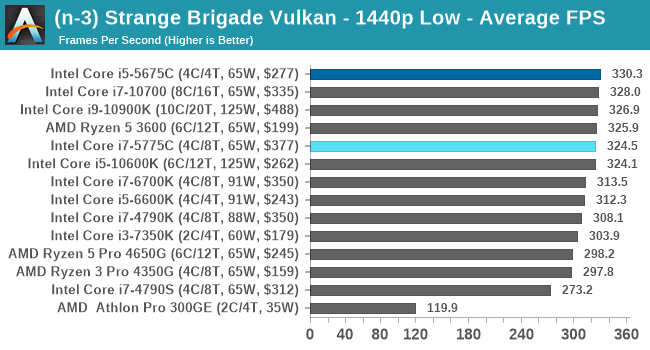 |
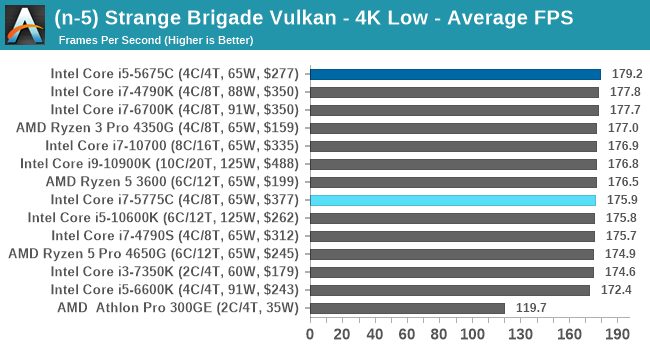 |
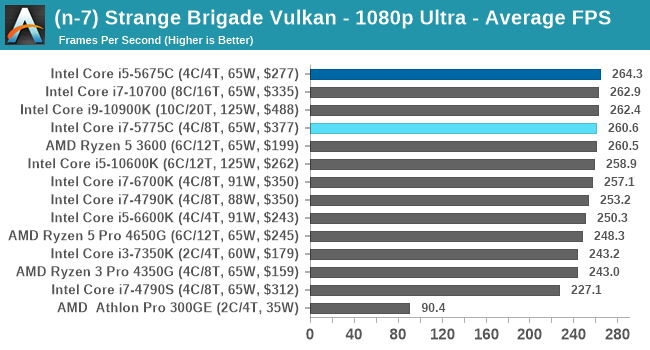 |
| 95th Percentile | 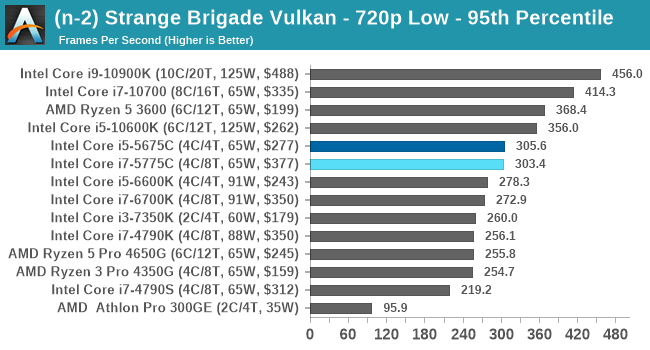 |
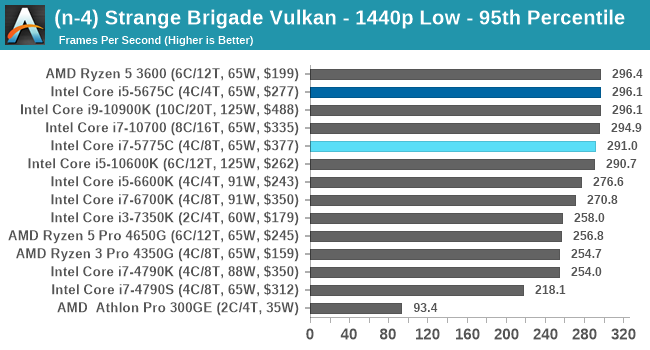 |
 |
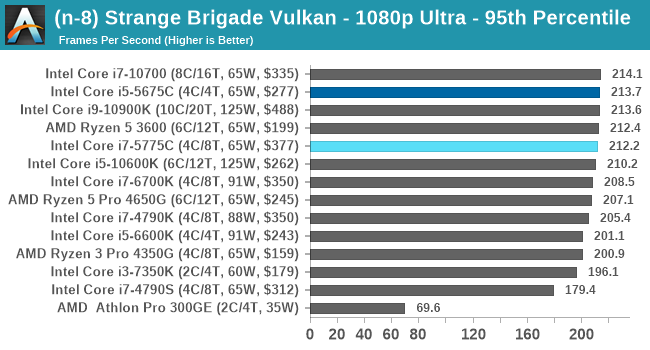 |
All of our benchmark results can also be found in our benchmark engine, Bench.











120 Comments
View All Comments
bernstein - Monday, November 2, 2020 - link
GDDR6 would be ideally suited as an L4 CPU cache... it has >500GB/s throughput and relatively low cost...e36Jeff - Monday, November 2, 2020 - link
Sure, if you build a 256-bit bus and somehow cram 8 GDDR6 chips onto the CPU package. You'd also be losing 30-40W of TDP to that.This is an application that HBM2 would be much better for. You can easily cram up to 4GB into the package with a much lower TDP impact and still get your 500+GB/s throughput. The biggest issue for this is going to be the impact of having to add in another memory controller and the associated die space and power that it eats up.
FreckledTrout - Monday, November 2, 2020 - link
This is also how I see it playing out. Certainly by the time Intel/AMD switch to using GAAFET maybe before. You just need a couple die shrinks that bring densities up and power down.bernstein - Monday, November 2, 2020 - link
scratch that, GDDR6 has much too high latency...stanleyipkiss - Monday, November 2, 2020 - link
The 5775C was ahead of its time. Don't know why they didn't go down that rabbit hole (of increasing the size with each gen)hecksagon - Monday, November 2, 2020 - link
Adding an extra 84mm2 of die area is a recipe for margin erosion, especially when the benefit is situational.CrispySilicon - Monday, November 2, 2020 - link
Well, I use a 5775C for my main home PC (using it now) and it's more than that. Broadwell was designed for low power. It doesn't run well over 4Ghz and it's not made to.My rig idles at about 800mhz, clocks up to 4ghz on all cores, 2ghz on the edram, and 2ghz on DDR3L (overclocked 1866 hyperx fury), yes, 3L, becuase THAT'S where the magic happens. Low power performance.
I've also used TridentX 2400CL10 modules in it, not worth the higher voltage.
I'm going to upgrade finally next year. CXL and DDR5 will finally retire this diamond in the rough.
Retest with nothing in the BIOS changed except the eDRAM multiplier to 20 and see what happens.
Notmyusualid - Wednesday, November 4, 2020 - link
I usually run my Broadwell at 4.4GHz 24/7. However I have a failed bios battery so using the m/b default 4.0GHz overclock settings today. I don't let mine idle at low speeds, its High Performance mode only & I only boot the Desktop for gaming, or Software Define Radio. Both of which want GHz.Memory is Vengeance LED 3200MHz (CL15 & only stable at 3000MHz, XMP is not stable either), and 32GB is currently installed.
Given;
C:\Windows\System32>winsat mem
Windows System Assessment Tool
> Running: Feature Enumeration ''
> Run Time 00:00:00.00
> Running: System memory performance assessment ''
> Run Time 00:00:05.45
> Memory Performance 54386.55 MB/s
> Total Run Time 00:00:06.65
I think that is why my Broadwell missed out on any eDRAM - it wasn't necessary.
Dolphin runs about 35x seconds, as I remember it.
6950X running cool in 2020...
MrCommunistGen - Monday, November 2, 2020 - link
HA. Epic timing. Just starting to read this now, but I recently built a system with a Broadwell-based Xeon E3 chip I got for cheap on eBay. Mostly just because I wanted to play with a chip that had eDRAM and the price of entry for an i5 or i7 has remained pretty high.This will be a very interesting read!
alufan - Monday, November 2, 2020 - link
News all day as long as its about Intel so it seems on here said it before and have seen nothing since to change my mind